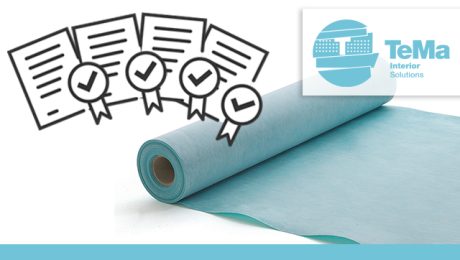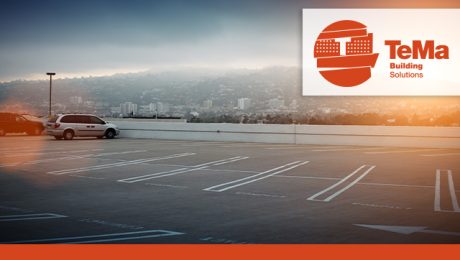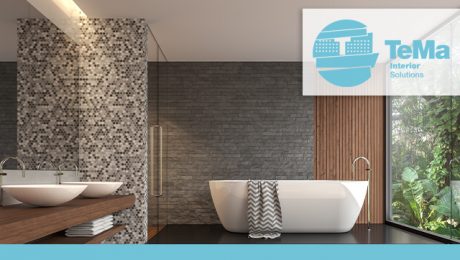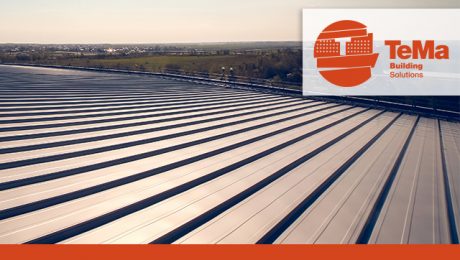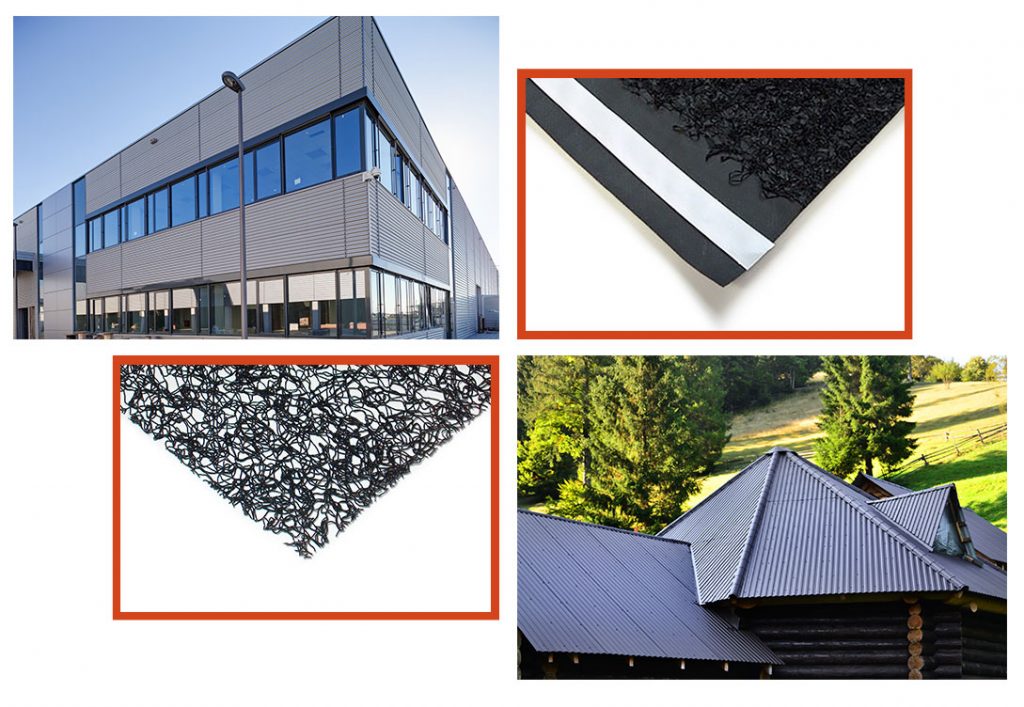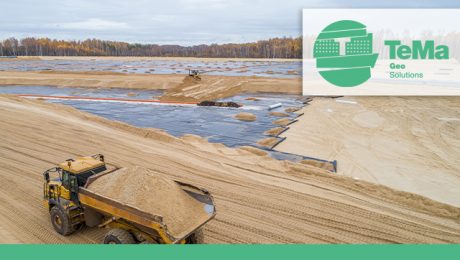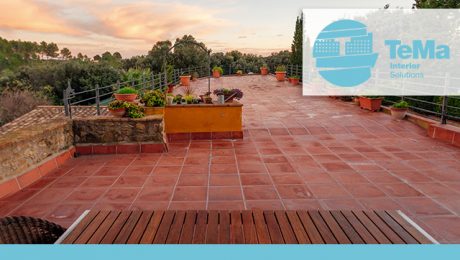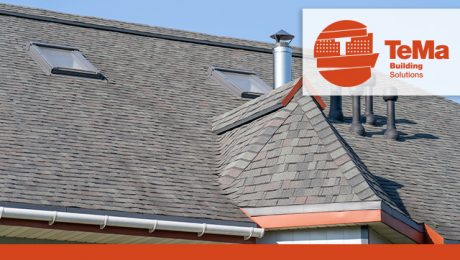TH2 Stop: certified waterproofing
As mentioned many times before, the problem of moisture and water vapour on walls and floors, both indoors and outdoors, is not to be underestimated. TH2 Stop from TeMa Interior Solutions, consisting of three layers, is the waterproofing membrane that fulfils its waterproofing function by blocking any damage caused by moisture before it forms.
Once the membrane has been applied, any surface can be laid over it: tiles, stone, cement resin, marble or plaster. It’s the ideal solution for insulating the bathroom from moisture and water vapour, keeping the surfaces healthy for a long time: as long as the life of the home. In renovations and in new buildings, installers prefer TH2 Stop for its safety and user-friendliness.
TH2 Stop is guaranteed to provide top performance and has been certified in Europe and beyond. US certification was obtained by passing the tests required by various standards:
- The ANSI A118.10 (American National Standard Specifications) regulation sets out the standard requirements for load-bearing, bonded, waterproof membranes for laying ceramic and natural stone tiles.
- The ASTM E96 standard for assessing membrane water vapour transmission, in accordance with the Annex.
- The ASTM C627 standard for passing the Robinson Wheel Test, with the highest Heavy Commercial rating.
At the European level, TH2 Stop has also obtained CE certification through ETA (European Technical Assessment) in compliance with ETAG 022 Class A and C (waterproofing bonded with ceramic tiles). The directive concerns watertight covering kits for floors and/or walls of indoor wet rooms.
TH2 Stop and its accessories can be used to seal joint areas between panels or adjacent sheets and all critical points, thereby creating a fully waterproof system.
For innovative products or products not yet covered by a standard, an alternative to harmonised EN standards is the issuing of a European Technical Assessment (ETA). This document consists of the approval of the suitability for use of a certain product, consistent with ETAG guidelines. ETAG guidelines are prepared under an EC mandate by a special European organisation EOTA (European Organisation for Technical Assessment) comprising national administrations and institutes responsible for assessing the technical suitability of innovative products.
TH2 Stop also passed the tests required by the European AbP (Allgemeines Bauaufsichtliches Prufzeugnis) standard, the most stringent in the industry. This building inspection certificate issued by accredited German building authorities in the sector allows the product to be distributed in the German market.
- Published in Baths and showers rooms, INTERIOR, Levelling, or structural, waterproofing panels, Waterproofing system with membranes
We will be at the EuroGeo7 Conference in Warsaw
After being postponed for so many months due to the health emergency, EUROGEO7, the 7th European Geosynthetics Conference will take place at last in Warsaw from 4 to 7 September 2022. We will be participating with our thirty years of experience and our innovative flow of products and functions.
We will be attending with ourTeMa Geo Solutions division, specialized in developing innovative technologies and products for protection, maintenance, retention, reinforcement and drainage in environmental works.
We have achieved these goals because since 1993, when TeMa was established, geosynthetic products have been our targeted approach to geotechnical and environmental applications. At a time when there was little talk of ecosystems, we developed considerable experience in this field, deploying new technologies and finding crucial improvements in terms of durability and less invasive intervention works using geosynthetic products.
The many fields of application range from the most important functions to be addressed in the fields of geotechnical engineering, reinforced earth structures and reinforced soil, to name but a few. They are highly impressive in the fields of hillside agriculture and the urban regeneration of small villages: drainage and filtration for landfills and contaminated sites; roads, railways and other transport applications; rainwater management.
What will TeMa Geo Solutions explore?
The focus is on geosynthetic products and the aspects that make them versatile, high-performance and innovative in geotechnical engineering applications. In particular, we will be focusing on TeMa Geo Solutions technologies for:
- removing seepage water using drainage geocomposites bonded with a nonwoven geotextile;
- reinforcement and stabilization with geogrids;
- the drainage capacity for the cap, bottom and sides of landfills with geonets;
- erosion control and drainage with geomats.
Our technicians will be available to provide catalogues and data sheets with performance details.
To learn more: https://www.temacorporation.com/geo-applications/
- Published in CORPORATION, Exhibitions and events, news, TeMa Technologies and Materials
Rooftop car park: next-level solution for making the most of underused space.
City centres are overcrowded with vehicles and restricted areas, car parks are “stressed” and there are never enough spaces to go round. Alongside the more “standard” trafficable ceiling slab solutions — such as in the case of underground garages — it’s not too much of a stretch, where structurally feasible, to think about designing or making better use of spaces on elevated levels.
Over the holidays, car parks on the roofs of public buildings or buildings for use by the public could also provide refuge for the cars of passers-through. During the offices’ closing time, for example, these parking spaces can become a real asset, an ideal solution for making use of otherwise unused space and increasing the number of car parks for people travelling to tourist hot spots
Continual vehicular traffic and exposure to the elements — from freezing temperatures to sweltering heat — mean the construction materials used must be fit for purpose. Intensive use means it’s imperative all the proper layers are in place (build-up design) to serve the different specific functions. Let’s see what these layers are.
What do we need to be careful about when designing a rooftop car park?
This kind of roof is subjected to high loads, both static and dynamic, from vehicles of all kinds. This makes the mechanical protection of the waterproofing layer and the need for high compressive strength two key focus areas.
Drainage is another aspect to be factored into the design. Rainwater can seep into the underlying layers and damage them, so we need to ensure that water is drained off the roof properly.
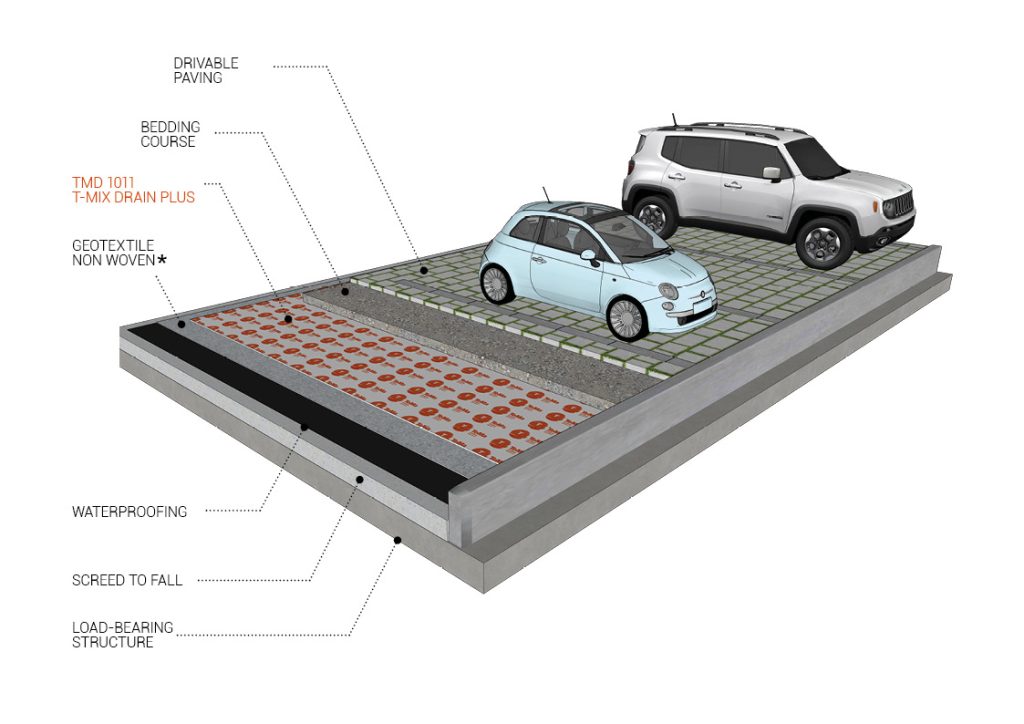
We recommend applying studded membranes laminated with nonwovens or drainage geocomposites made from monofilaments or geonets.
Our drainage geocomposite T-Mix Drain Plus is a good candidate for the drainage layer. Alternatively, you can opt for the T-Net Drain 5 and T-Net Drain 7 geonets, which are sandwiched between nonwovens.
The job of mechanical protection, together with drainage, can instead be handled by the drainage geocomposite TMD 1011. The product consists of a filter geotextile laminated to a studded membrane, whose conformation delivers effective drainage even under the strain of high loads (up to 400 kPa).
- Published in BUILDING, Drainage geocomposites
Furnishings and accessories for designer bathrooms
Large or small, square or rectangular, with or without a panoramic view, the bathroom is always an intimate place that needs to combine functionality with relaxation. It’s a room that’s used very often, which is why everyone tries to make it a pleasant experience and personalise it according to their own taste.
A new soap dish, a rug to contrast with the floor and a larger mirror are good starting points, but it’s strictly in architectural terms that spaces can be customised.
Let’s see how.
SOLUTIONS FOR NEW CONSTRUCTION
The first thing to bear in mind is the fact that the bathroom is a place with a high amount of humidity and vapour, therefore any intervention works must provide suitable long-lasting solutions.
The TeMa Interior system allows many intervention works to make your bathroom extremely personal, including creating walls, making the spaces you want and external cladding for the bathtub with a whirlpool and shower, or creating structures for washbasins, shelves, niches or small cabinets.
Water Panel gives you the opportunity to create self-supporting partition walls for a sophisticated look in the bathroom. Its wide range of thicknesses (see data sheet) makes it an extremely adaptable and functional product.
It can be used as cladding for the bathtub and shower, also because it’s waterproof and prevents the risk of water seepage, which would cause costly damage, and conceals fixtures, therefore becoming a true furnishing element. In addition, since it’s cut to size, it offers the very advantageous option of making the shower or bathtub the required size.
Also for washbasins and walls for the installation of sanitary fixtures, creative solutions can be found with Water Panel: the structure supporting them, whether just one or many more, can be custom-made with a mirror recess and shelves.
Of course, Water Panel can be cladded with your choice of finish: tiles or plaster.
To make it even more visually attractive, you can choose to include niches thereby maximising the use of space. T-Niche is the ideal waterproofed prefabricated product for all your needs.
The above-mentioned products are very light, extremely easy to handle and can also be carried to upper floors without requiring a freight lift.
RENOVATION SOLUTIONS
Workers in the house, bathrooms out of use and dust everywhere: the nightmare can be minimised if you choose to waterproof your shower with TH2 Stop, the membrane that can be applied under tiles with standard cement glue and cladded as desired.
Accessories
To complete the work at critical points, such as corners, specific products can be used such as T-Corner I and T-Corner E, whereas at panel joints, where there are fixtures and drains, T-Bandel can be applied and fixed with T-Fix.
What are the advantages?
All solutions can be customised to the millimetre, on-site and without causing any dust, for quick installation. This allows unprecedented speed of work with the highest performance ever.
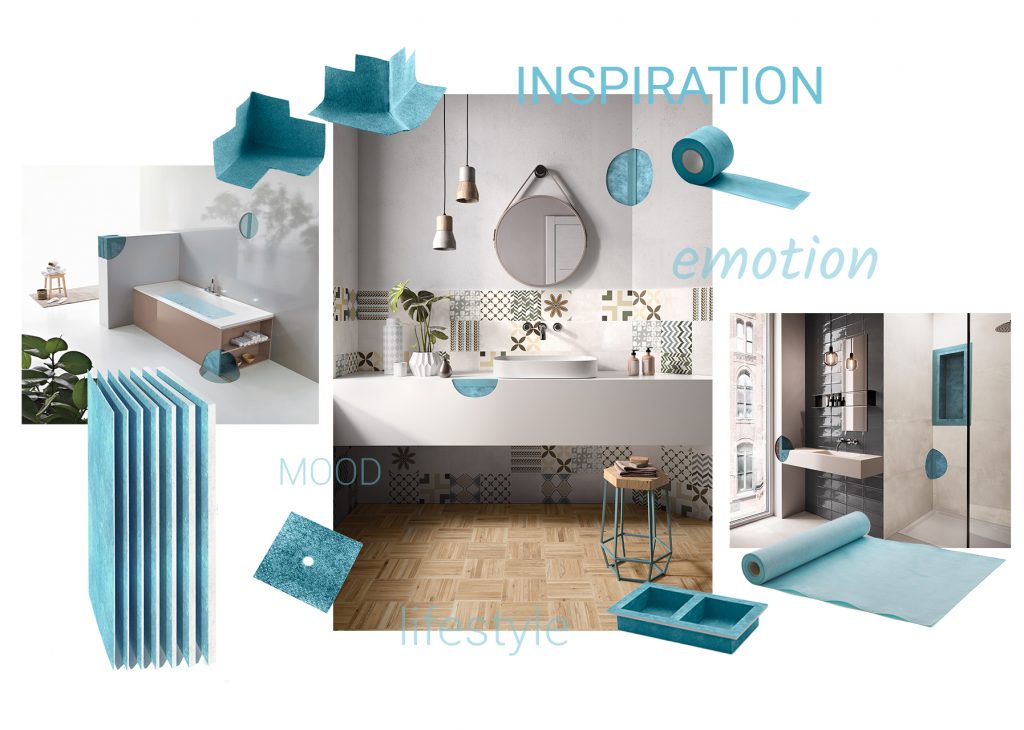
- Published in Baths and showers rooms, INTERIOR
Controlled landfills and the importance of isolating them
Landfills for inert, non-hazardous and hazardous waste are governed by specific laws in each country, which set out precise regulations on the construction and maintenance of these sites.
As they are virtually in the ground and designed for certain types of waste, they must meet environmental and safety standards.
Let’s take a look at everything in detail.
The risks of not isolating them
Assuming that proper disposal is essential, many types of waste can take years, even decades, to disintegrate and complete natural decomposition processes. At this stage, they produce a large amount of slurry, such as leachate, which is extremely contaminating for the soil and for groundwater.
Moreover, biogases are also produced, mainly methane and carbon dioxide, due to the breakdown of organic material, which must be controlled and could be used to produce renewable energy.
How to isolate them
Controlled landfills need to be isolated from the ground that hosts them, but to be safe they need to fulfil different functions.
Surface erosion control
Vegetation naturally protects the ground from erosion by weather conditions such as wind and rain, which would cause subsidence. While waiting for grassing to protect the sides and surface of the landfill, anti-erosion geomats, in a biodegradable and synthetic version, can be chosen according to needs.
TeMa Geo Solutions offers a wide range to choose from, which can be browsed here.
Reinforcement
A landfill site is sometimes designed and built on more or less steep slopes. If a slope is steep and the ground is unable to support itself, retaining grids need to be installed in order to prevent slippage, which would expose and damage lower layers. View all our solutions.
Drainage
Specific products, drainage geocomposites, can be used for the drainage of rainwater and leachate, which inevitably builds up and must be kept away from the ground.
Barrier
Bentonite-based products, such as Barrier Bento, allow the area to be waterproofed, including walls with high slopes and the bottom.
Capping
Landfills also have a final cover that must meet precise criteria. These include isolating waste from the ground and surface erosion control. However, minimising water seepage and blending into the landscape are equally important.
Proud to be BEE certified
Our strength is that we never stop striving for the best, in everything: we are at the forefront in researching new materials, studying innovative solutions, focusing on the environment and exploiting resources… We couldn’t be any less inclusive.
Our company operates worldwide, we have branches in practically all continents and the concept of ‘internationalisation’ is our daily bread. We have always worked in contact with different people and cultures and have no difficulty in approaching them: it comes naturally to us!
We are therefore delighted to have been awarded BEE certification for our TeMa South Africa division.
What is it and how does it work?
Broad-Based Black Economic Empowerment, or B-BBEE, is a South African government initiative that encourages businesses to integrate more black citizens into all jobs, from employees to entrepreneurs, and reduce inequality in income.
The assessment is made based on 5 parameters:
- Ownership: voting rights and shareholding in the company
- Management control: members in management roles and voting rights with control over the board of directors
- Skills development: learning opportunities for developing new skills
- Enterprise development: support and development of small businesses run by black people
- Socio-economic development: corporate investment in economic and social initiatives.
Each parameter is assigned a value that creates the final percentage score, which is used to assign the category level. There are 8 of them, proceeding in descending order: 1 is the level with the highest score, 8 with the lowest score.
TeMa South Africa has been assessed by the EmpowerBEE certification agency and is a certified collaborator at Level 3 – 110% procurement recognition level.
We aim to improve further in order to reach the highest level.
Click here to find out more.
- Published in CORPORATION, news
Protecting outdoor flooring with drainage geocomposites
Autumn precipitation, winter frosts and scorching summer heat may even be followed by a downpour lasting a few minutes. Terraces and balconies, or outdoor flooring in general, are affected by seasonal and sometimes daily weather events and temperature fluctuations that put the resistance of flooring at risk.
So how can we protect them?
Drainage geocomposites are the solution, but let’s take a closer look at them and their functions.
What are drainage geocomposites and when should they be used?
They are geosynthetic materials with a drainage core bonded to a non-woven filtering fabric. They can be used on walls, underground structures, flat roofs, trafficable roofs, flat green roofs, as well as terraces, balconies and outdoor flooring.
TeMa Interior Solutions suggestsT-K NW and T-K Net, polyethylene studded membranes bonded to a non-woven fabric that acts as a filtering layer for T-K NW or a HDPE mesh for T-K Net.
What are the functions?
The functions of geosynthetic products are set out in the UNI EN ISO 10318 standard.
![]()
Drainage
As the name implies, the main function of geosynthetic products is to drain any water that may seep into the screed. Passive capillary drainage eliminates the risk of stagnant water in the system and, if there are rooms below, prevents moisture from damaging the insulating layer.
![]()
Protecting the waterproofing layer
Damage to the waterproofing layer causes significant and immediately visible problems. Moisture and water penetrating into deeper layers, compromise the durability and strength of the structure, causing cracks in tiles. Protection is therefore necessary.
![]()
Distributing the load
Flooring often has to withstand heavy loads, such as outdoor tables, sunshades, large plant pots etc…. Using studded membranes, which are highly resistant to loads, allows the screed to remain “suspended” from the sealing layer (i.e. the waterproofing layer) below, protecting it from perforations and abrasions.
Advantages of applying the system
The time required is extremely short and flooring can be laid after a few days.
The thickness of the membranes is much reduced, an advantage not to be underestimated in renovations. Moreover, the thresholds of French windows opening outwards or onto a terrace do not need to be raised.
Lastly, in consideration of the environment, the materials are safe and odourless. They do not develop toxic gases or organic components, and comply with VOC standards. No hazardous substances are released underground.
New solutions in road construction and/or repairs
The safety of road infrastructures is the main goal, and maintenance work – whether preventive or supplementary – is systematic.
Road surfaces withstand heavy traffic loads and atmospheric changes with significant variations in temperature. Constant maintenance is therefore required in order to ensure even surfaces and the stability of structural elements.
Let’s look at the main factors involved in building new roads or maintaining roads.
Controlling surface erosion
Erosion is largely due to freeze/thaw cycles, which make asphalt less elastic and therefore more prone to internal voids. Such voids allow water to penetrate into underlying layers, gradually eroding the structure.
In addition, heavy traffic loads, especially heavy vehicles, cause deformation of the surface layers: this results in water penetration, which “softens” the structure and makes it less resistant.
Anti-capillary drainage
The water capillarity, i.e. the ability of liquids to move in micro-spaces even against the force of gravity, is a rather complex concept closely monitored in the construction industry. With the help of pressures exerted on lower layers, water rises upwards, dragging the finer components of materials with it and causing deformation.
It is therefore necessary to provide a drainage geocomposite, a three-dimensional membrane obtained by bonding two or more synthetic components in order to convey fluids to the exterior and prevent them from rising.
You can discover all our solutions here.
Reinforcement
It may sometimes be necessary to install reinforcement grids, especially if there is a more or less pronounced slope that would cause a road shoulder to slide downwards.
The choice of the most suitable type of reinforcement, and therefore also of the position of the geogrid in the layering, clearly depends on the problems to be faced i.e. reinforcing the surface area to limit the spread of cracks to underlying layers, improving the load-bearing capacity and reducing the stresses transmitted to lower layers, or providing a separation (and anti-contamination) function.
Discover all our solutions here.
Stabilisation
During intervention works, softer soils may be encountered, which may be subject to instability or even collapse in the early stages of intervention works. Even if this should not jeopardise the feasibility of the works, there is still the risk that the minimum legal safety requirements will be compromised.
Also in this case, geosynthetic products are the solution to the problem, as they absorb tensions at least until the intervention work achieves structural stability.
Discover the solutions in the X-Grid line here.
- Published in Drainage geocomposites and membranes, Erosion mats, GEO, Geogrids, Roads

